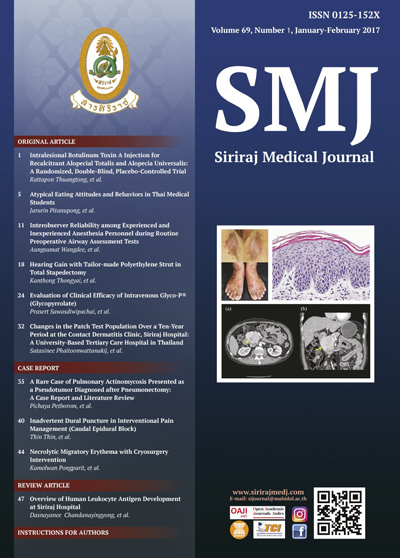Intralesional Botulinum Toxin A Injection for Recalcitrant Alopecial Totalis and Alopecia Universalis: A Randomized, Double-Blind, Placebo-Controlled Trial
Keywords:
Intralesional botulinum toxin A injection, alopecial totalis, alopecia universalis, recalcitrant alopecial totalis, recalcitrant alopecial universaliAbstract
Background: Alopecia totalis (AT) and alopecia universalis (AU) have a high rate of recurrence and are very difficult to treat. To date, no consensus has been reach among clinicians regarding the best way to treat these conditions. It was recently proposed that botulinum toxin type A (BT) injection in alopecia areata may inhibit unmyelinated C fibers from releasing substance P and calcitonin-gene-related protein (CGRP), which showed a favorable clinical response in cephalalgic alopecia areata.
Objective: To investigate the efficacy of botulinum toxin type A (BT) in the treatment of recalcitrant AT and AU.
Methods: Twenty patients with either recalcitrant AT or AU were enrolled in this study. One half of the scalp was injected with BT 50 units 2.5 ml intradermally (dilution 20 units/ml) and the other half of the scalp was injected with normal saline 2.5 ml. Clinical assessments were performed using Severity of Alopecia Tool (SALT) score, scalp mapping, and photography. Patients were followed up monthly for 4 months after treatment to evaluate terminal hair regrowth.
Results: Based on patient results at the 4-month follow-up, no clinical improvement in either recalcitrant alopecia totalis or alopecia universalis was observed.
Conclusion: Although BT has been demonstrated to improve the clinical features of cephalalgia alopecia areata, BT was not shown to improve the clinical features of recalcitrant AT or AU in this study. In order to understand and explain the differences in these two clinical outcomes using BT in alopecia, further investigation is needed.
Downloads
Published
How to Cite
Issue
Section
License
Authors who publish with this journal agree to the following conditions:
Copyright Transfer
In submitting a manuscript, the authors acknowledge that the work will become the copyrighted property of Siriraj Medical Journal upon publication.
License
Articles are licensed under a Creative Commons Attribution-NonCommercial-NoDerivatives 4.0 International License (CC BY-NC-ND 4.0). This license allows for the sharing of the work for non-commercial purposes with proper attribution to the authors and the journal. However, it does not permit modifications or the creation of derivative works.
Sharing and Access
Authors are encouraged to share their article on their personal or institutional websites and through other non-commercial platforms. Doing so can increase readership and citations.











